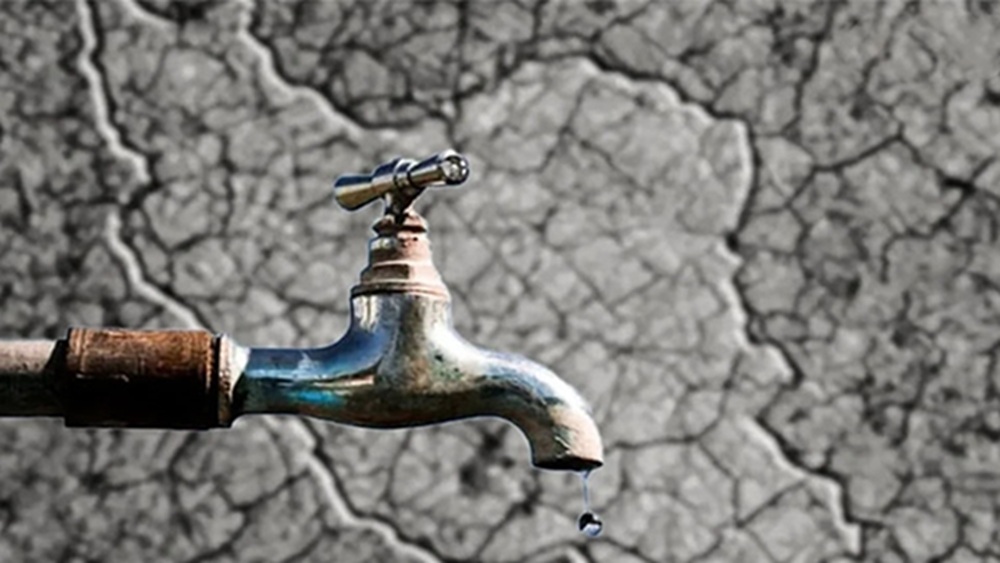
Three-minute read
Iran is not merely facing a water crisis; it is confronting a state of “water bankruptcy.” This term, used by experts to describe a systemic collapse of water resources, points to a catastrophe engineered not by nature, but by decades of the Iranian regime’s corruption, mismanagement, and the profiteering of the Islamic Revolutionary Guard Corps (IRGC). As millions of Iranians now face the rationing of drinking water, the evidence shows this disaster was both predictable and deliberately ignored.
The crisis is not a matter of insufficient rainfall but of systemic plunder. The facts reveal a government that has consciously drained the nation’s lifeblood for financial and political gain, leaving ordinary citizens to bear the devastating consequences.
The Anatomy of a Manufactured Drought
The scale of the regime’s mismanagement is stark. Official data from the state-run Amag website reveals that Iran extracts approximately 63.8 billion cubic meters of groundwater annually, while the natural rate of replenishment for these sources is only 45 billion cubic meters. This massive deficit is a deliberate policy of over-extraction that has been pursued for years, leading to the depletion of vital aquifers.
#Iran Water Crisis Deepens As 19 Dams Near Depletion; Mashhad Reservoirs Below 3%https://t.co/4wfyLASV8l
— NCRI-FAC (@iran_policy) November 10, 2025
Furthermore, over 80% of the country’s renewable water is allocated to agriculture, a sector whose export profits disproportionately benefit regime-affiliated entities. This misallocation prioritizes the financial interests of a select few over the sustainable management of a resource essential for the entire population’s survival.
The IRGC: The Profiteering “Water Mafia”
At the heart of this crisis is the Islamic Revolutionary Guard Corps (IRGC), which operates a water mafia. The IRGC has spearheaded massive and environmentally ruinous dam-building projects across Iran without proper ecological assessments. These projects have disrupted natural water flows, dried up rivers, and created severe social tensions over water rights in provinces like Sistan and Baluchestan, Kerman, Fars, and Isfahan.
The IRGC’s focus is not on sustainable management but on securing lucrative, large-scale contracts. This is evident in its push for expensive and technologically intensive “solutions,” such as the $204 million desalination plant in Bandar Abbas, according to Amag. These projects serve as a pipeline for channeling state funds into the pockets of IRGC commanders and their affiliates, while failing to address the root causes of the water crisis.
Deflection and Deceit: Blaming Women for Lack of Water
Rather than addressing its catastrophic policy failures, the regime has resorted to bizarre ideological deflections to evade responsibility. In a stark example, Mohsen Araki, a member of the Assembly of Experts, publicly claimed that the water crisis, drought, and lack of rainfall were divine punishment for women failing to observe the mandatory hijab.
This rhetoric serves not only as a grotesque attempt to shift blame from corrupt institutions to the public but also as a clear indicator of a leadership completely detached from reality and scientific governance. By framing a man-made disaster as a moral failing of the people, the regime seeks to absolve itself of all accountability.
#Iran's Regime Floats Tehran Evacuation Contingency as Water Runs Outhttps://t.co/LRTfl2An9A
— NCRI-FAC (@iran_policy) November 10, 2025
A Deliberate Policy of Denial
The regime cannot claim ignorance. Experts have been sounding the alarm for years, only to be silenced. In an interview with state media, Kaveh Madani, former Deputy Head of Iran’s Department of Environment and current Head of the UNU Institute for Water, Environment and Health, confirmed that the crisis was long in the making.
In a striking anecdote from his time in government, Madani recalls using the term “water bankruptcy” in a meeting of the Supreme Water Council. Instead of heeding the warning, a senior official admonished him, saying, “Young man, don’t say such things.” This incident reveals a deliberate policy of denial at the highest levels of power, where scientific warnings were actively dismissed to protect the vested political and economic interests of the ruling elite.
The thirst gripping Iran is not an act of nature but a direct and inevitable consequence of the regime’s corruption and incompetence. The over-extraction of groundwater, the IRGC’s destructive and self-serving mega-projects, and the cynical deflection of blame all point to a system that is fundamentally at war with its own people and environment.
#Iran’s Domestic Capacity Crisis: Food, Water, and Urban Safety Under Structural Breakdownhttps://t.co/mjZ5lidgey
— NCRI-FAC (@iran_policy) November 4, 2025
This water bankruptcy is a symptom of a much deeper political bankruptcy. The crisis proves, once again, that the regime is incapable of and uninterested in serving the needs of the Iranian people. And it once again proves that the ultimate solution is the removal the root of the problem, which is the regime itself.

